
Spain’s gender pay gap: Convergence faces upcoming challenges
Over the last two decades, Spain’s gender pay gap has narrowed significantly, from 29% in 2002 to 17% in 2022. However, recent stagnation in convergence is prompting a debate about the policies that need to be adopted for continued progress in the years to come.
Abstract: An analysis of data from the Wage Structure Surveys undertaken between 2002 and 2022 reveal that over the last two decades, Spain’s gender pay gap has narrowed significantly, from 29% in 2002 to 17%. The meaningful reduction so far this century appears to be partly attributable to higher labour intensity and significant flows of women into higher-paid sectors and occupations over the last decade. However, the most recent data suggest that the pay gap is currently stagnant at 2022 levels, prompting a debate about the policies that need to be adopted, such as those aimed to deliver more equitable childcare and more flexible working hours, to achieve further convergence in the years to come.
The trend in the gender pay gap in Spain in the twenty-first century
The gender pay gap in Spain has attracted significant attention and criticism following the rapid incorporation of women into the workforce at the end of the twentieth century. Analysis of this important variable has sparked lively debate every time the related statistics are updated. However, that analysis often fails to look at a sufficiently long period of time to assess the trend in this gap over more than a decade. Reduction of the gender pay gap is a cross-cutting thrust within Spain’s recovery, transformation and resilience plan, piling further pressure on the need to lessen it in the near future.
Thanks to the microdata gleaned from the
Wage Structure Survey, which are published by Spain’s statistics office (INE) every four years, we can observe the trend in the gender pay gap over most of this century, specifically from 2002
[1] until 2022, the last year for which these figures are available. In just 20 years, the gender pay gap in Spain has decreased very considerably, from close to 30% at the century’s turn to 17% in 2022.
The reduction in the pay gap has been even more intense in terms of gross hourly earnings than in terms of gross annual earnings, suggesting higher flows of women into sectors and occupations with higher pay per hour over the course of the last two decades. Specifically, the pay gap in terms of hourly earnings has fallen by half, from 20% in 2002 to 9.4% in 2022, which is the first year in the entire series in which this metric dipped below 10% (Exhibit 1).
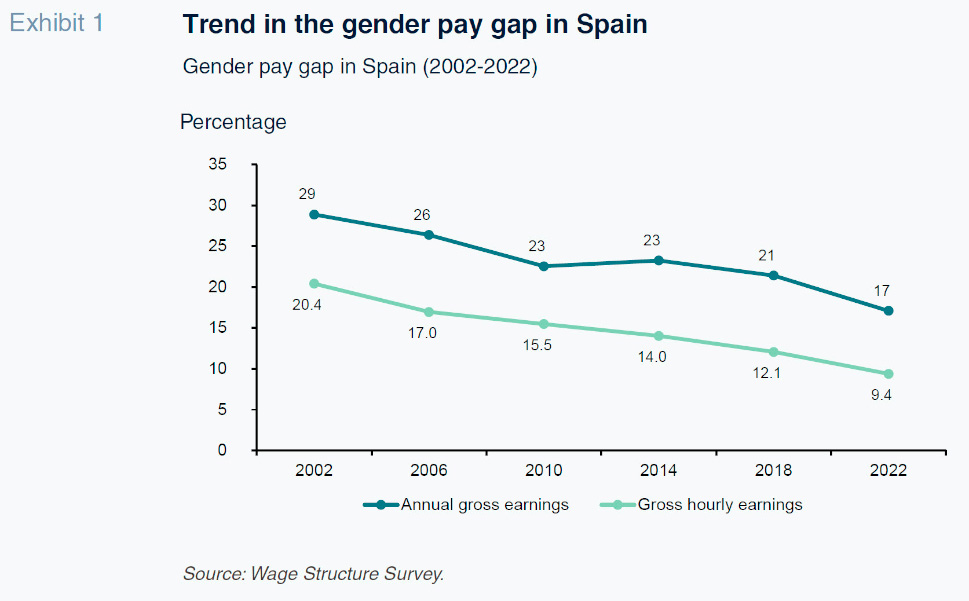
The drop in the hourly earnings pay gap is not attributable solely to a higher share of women in the workforce: other factors are at play, such as a higher level of education and increased presence of women in higher-paid sectors, to provide a couple of examples. However, the drop in the hourly earnings pay gap may also be due to an inter-sector movement of female employees into positions that are higher paid on an hourly basis. Exhibit 2 attempts to shed light onto the effect each of these two channels (on the one hand, the reallocation of employees across different sectors and the reallocation across occupations, on the other) has had on the changes in pay and reduction in the pay gap since 2010. Although the data demonstrate a positive correlation between both the reallocation of women across sectors and across occupations and growth in their average earnings, unlike what we see for men, the correlation is considerably stronger in terms of occupations (panel A) than economic sectors (panel B).
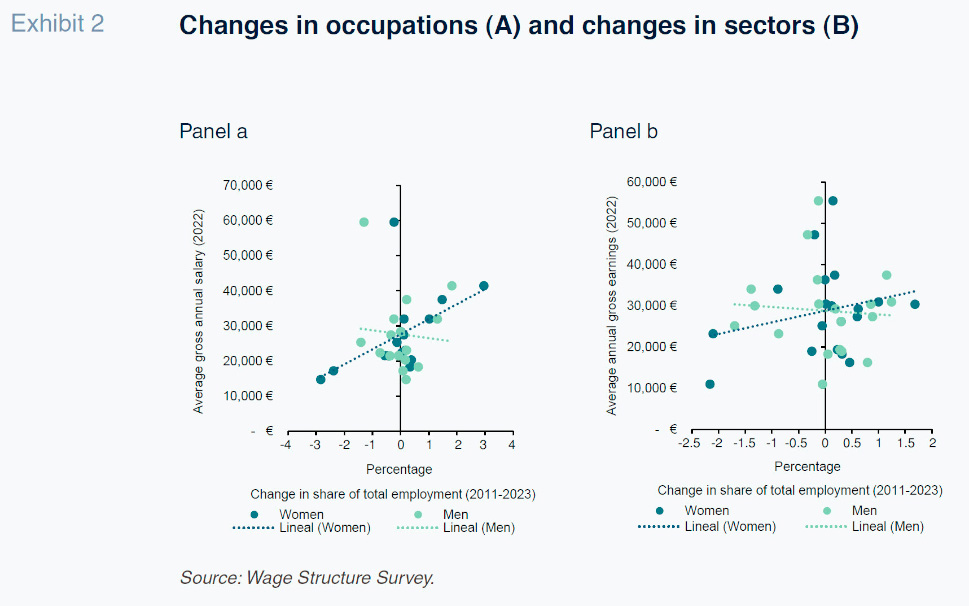
To get an idea of the magnitude of the effect of each channel, we carry out a simple counterfactual exercise in which we assume the average earnings per sector and per occupation for 2022 but apply the shares commanded by women for each occupation/sector in 2011. Under those assumptions, women’s average earnings would be 2.6% higher if they continued to hold the same shares in the various sectors and 4.6% lower if they held the same shares of the various occupations, indicating that shifts among occupations played a considerably bigger role than cross-sector moves, albeit quantitatively relevant in both instances.
As would be expected, these changes in the composition of the labour market are being driven primarily by the younger generations of women who have been entering the job market and beginning their careers in recent years. It is therefore no surprise that pay gaps have contracted more intensely among the youngest age groups. Most significantly, the pay gap in terms of hourly earnings has effectively disappeared among employees aged between 20 and 30, currently standing at just 1% (Exhibit 3).
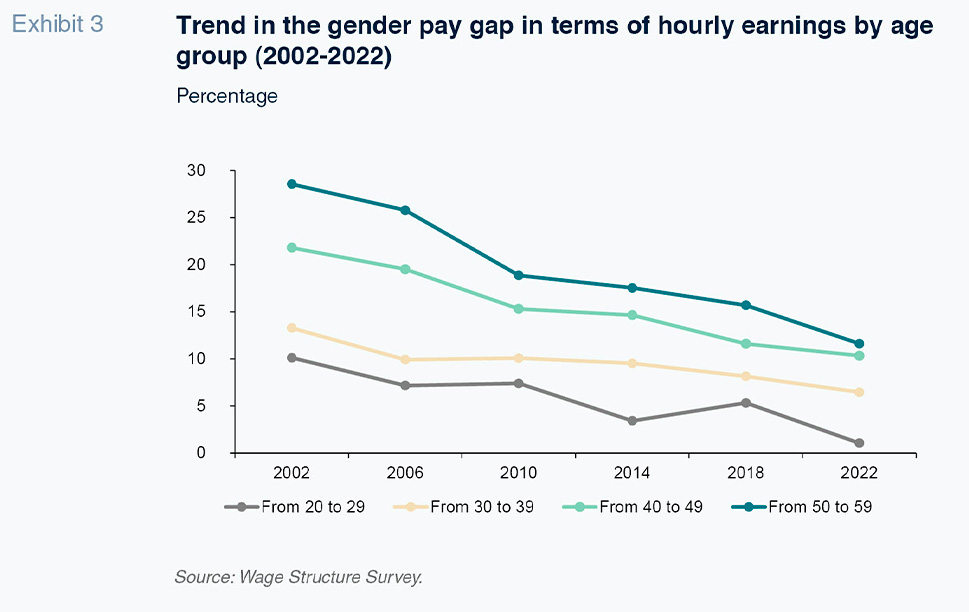
Now that we understand the effect played by the reallocation of employees across sectors and occupations in reducing the gender pay gap, the next question is what share of the more recent reduction has had to do with the increase in hours worked, which recent analyses (Hidalgo, 2024) have cited as one of the main sources of wage growth for low-earners in recent years.
Role played by the number of hours worked in reducing the gap (2014-2022)
The academic literature in gender pay gap field has consistently identified the intensity of work, measured using both contractually-agreed working hours and the number of months worked, as one of the main factors behind the pay gap and its performance over time. In fact, recent evidence for Spain (de Quinto et al., 2021) shows that these two channels of impact, working hours and days worked, are key to explaining the origin of the gender pay gap that materialises after the birth of a first child. Their work shows, as was expected, that the adjustment channels available are used differently by women depending on their level of education, with women with higher studies tending to reduce their working hours and women with lower levels of education tending to reduce the number of days they work per year.
With all this in mind, it is reasonable to think that at least part of the reduction in the pay gap in recent years may have been driven by changes in the number of hours worked. Given that the gap analysis for this paper does not take into account differences between men and women in the number of days worked, we focus solely on the potential role of longer working days for women, which we can break down into different segments.
The next exhibit shows the trend in the average number of hours worked per month by men and women according to the last three Wage Structure Surveys, which were carried out in 2014, 2018 and 2022. Although the change in the number of hours worked was very small between 2014 and 2018, it looks as if the increases observed between 2018 and 2022, of 1.6% in the case of men and 2.8% in the case of women, may have contributed to the reduction in the pay gap during that period of time.
Interestingly, although one might think that the increase in the average number of hours worked by women might be associated with a sharp drop in the percentage of women working part-time, the incidence of part-time work has decreased more intensely among men than women since 2018 (by 2 percentage points in the case of men, compared to 1.5 points in the case of women), suggesting that the increase in the number of hours worked by women was more likely shaped by growth in the hours worked within the cohort of female employees working part time (Exhibit 4).
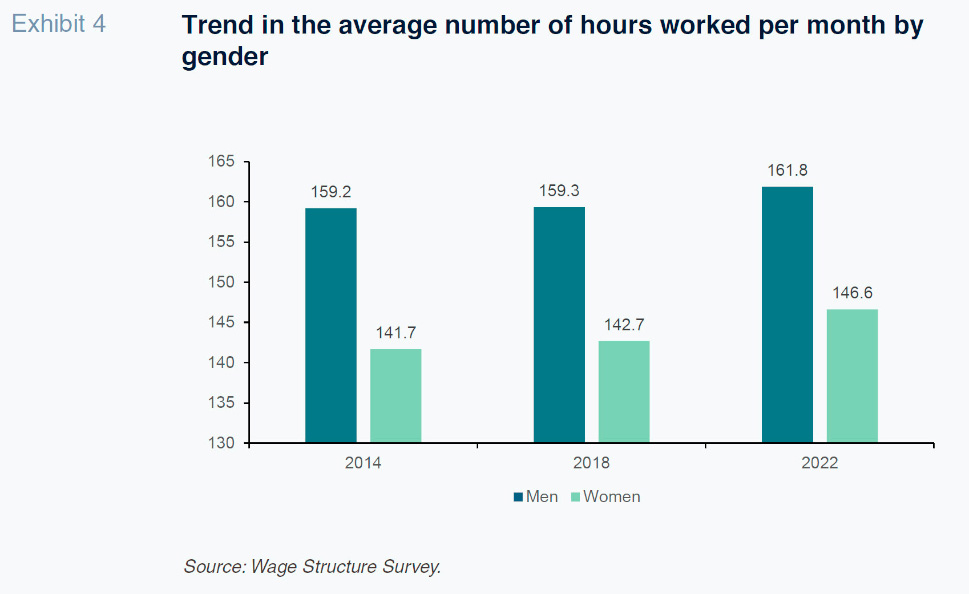
To measure the positive effect of this divergent growth in the number of hours worked by men and women between 2018 and 2022, we simulate the trend in the pay gap in terms of gross annual earnings between 2014 and 2022 had the average number of hours worked by women per month not changed during that timeframe, staying rather at the levels observed in 2014. In other words, we calculate what the pay gap would have been assuming that hourly earnings did continue to rise (shaped by the composition effects documented in the last section) but that the number of hours worked did not. As a result, the difference between the two series can be seen as a proxy for the contribution to the reduction in pay gap by the relatively faster growth in the number of hours worked by women.
Exhibit 5 depicts the two series between 2014 and 2022. The positive effect of work intensity on the drop in the gender pay gap narrows with time, particularly between 2018 and 2022. The findings suggest that the pay gap in 2022 would have been 1.4 points higher if the number of hours worked had stayed constant at 2014 levels. Considering that the gender pay gap contracted by 5.5 points over that time span, the contribution by the number of hours worked on the overall reduction in the gap amounts to 25%. In other words, one-quarter of the reduction in the pay gap during that period can be explained by the higher growth in the average number of hours worked by women compared to men, with the remaining three-quarters attributable to the reduction in the pay gap in terms of hourly wages.
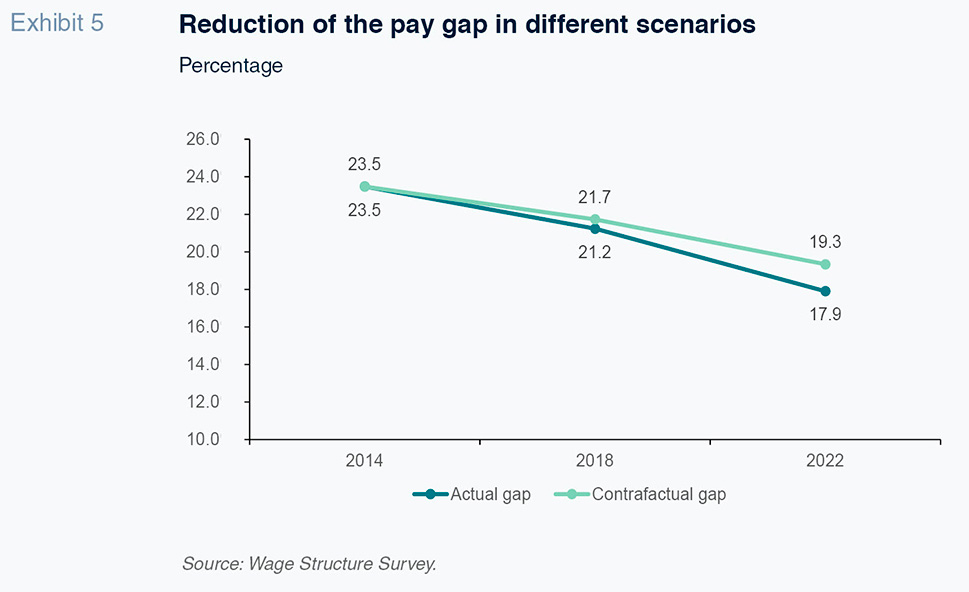
Trend in the adjusted pay gap
In addition to quantifying the gender pay gap, the literature in this field usually estimates the pay gap adjusted for the observable characteristics of the employees and the work they do. In this last section, we calculate the adjusted gender pay gap from 2014 to 2022 by estimating a minimum least squares model that considers the basic characteristics of an employee, such as his or her region of residence, age, experience and level of education, the characteristics of his or her work (occupation, sector, main market for the company and job responsibilities) and lastly, firm-specific traits such as size in terms of employee headcount.
Exhibit 6 depicts the trend in the three pay gap measures: gross annual earnings, gross hourly earnings and adjusted hourly earnings for each of the three cutoffs. In contrast to the trend observed in the gaps measures in terms of annual and hourly pay, the trend in the adjusted pay gap has been far more disappointing, decreasing by just one point, compared to decreases of between four and six points for the other gender pay gaps analysed. This lacklustre underperformance in the adjusted pay gap since 2014 suggests that most of the contraction in the gap in terms of annual earnings may be explained by the higher intensity in the number of hours worked of the composition effect in terms of employees characteristics, rather than a reduction in the adjusted gap.
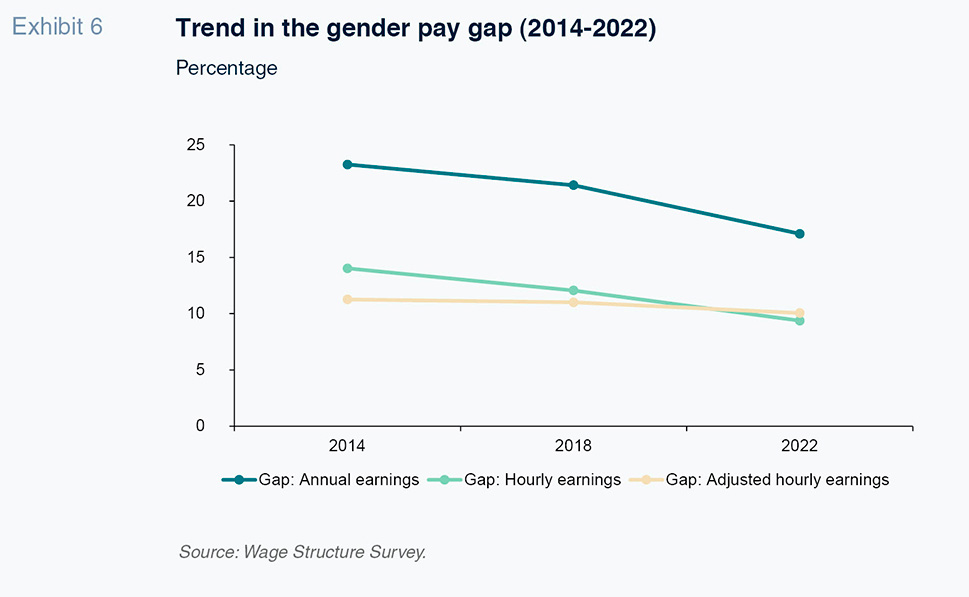
There may be several reasons for these differences, such as stagnation in the assumption by men of shared responsibilities in the home or sharp pay cuts in exchange for flexibility around working hours, among other, with different factors coming into play in different employee categories and sectors. To try and identify in which sectors of the labour market the adjusted pay gap has fallen more intensely, we estimate the model separately for workers with and without higher-level studies and for public and private sector employees.
The results, presented in the Exhibit 7, indicate relatively more intense reductions among employees without higher-level studies and public sector workers relative to employees with third-level education and private sector employees. An alternative hypothesis for explaining this difference in the reduction in the adjusted pay gap depending on employees’ education levels can be found in the actual disaggregated Wage Structure Survey data. If, within a group of female employees with higher studies, the women remain under-represented in the degrees with higher pay expectations (such as STEM degrees) (Cobreros
et al., 2024), these composition differences among the highest educated female employees, which cannot be taken into consideration in the wage equation due to a lack of data in the area of higher studies, might explain why the adjusted pay gap has barely moved in this particular cohort.
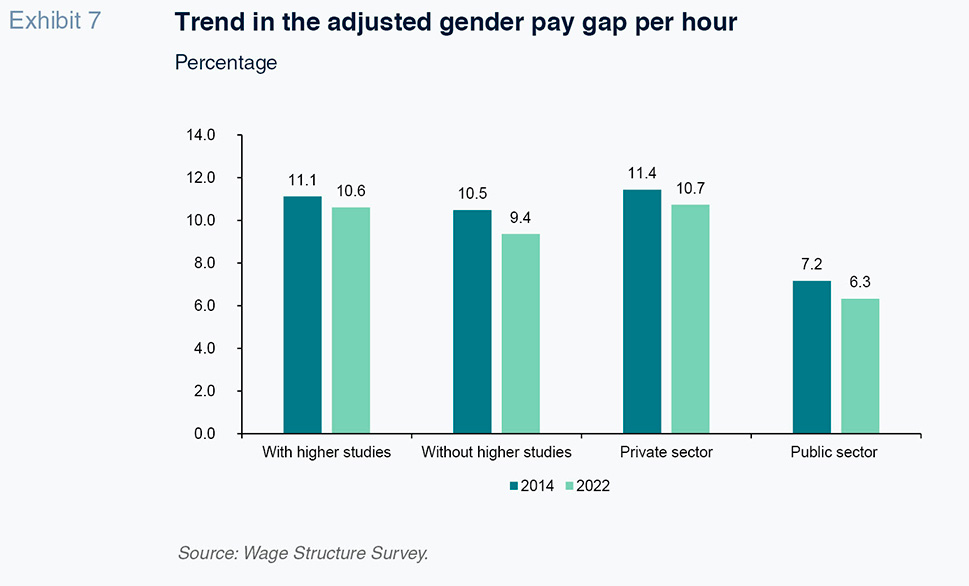
Unfortunately, the usual lag in obtaining official statistics limits our overall analysis to 2022, the last year for which the INE has published disaggregated microdata in any of the national surveys containing salary information. However, we have much more recent data with which to calculate pay gap proxies: the social security contribution bases, which despite offering a biased result due to the existence of minimum and maximum bases, can provide some insight into how the pay gap has trended in 2023 and part of 2024.
Exhibit 8 depicts the trend in the average contribution base between men and women from January 2018 until April 2024. As expected, between 2018 and 2022, the average female contribution base increased at a faster rate than the male equivalent, in keeping with the earlier findings. In contrast, growth in average bases between both sexes was extremely similar in 2023 and the first few months of 2024, at around 4% in both cases, suggesting that, at least in recent times, the gender pay gap in Spain has stagnated.
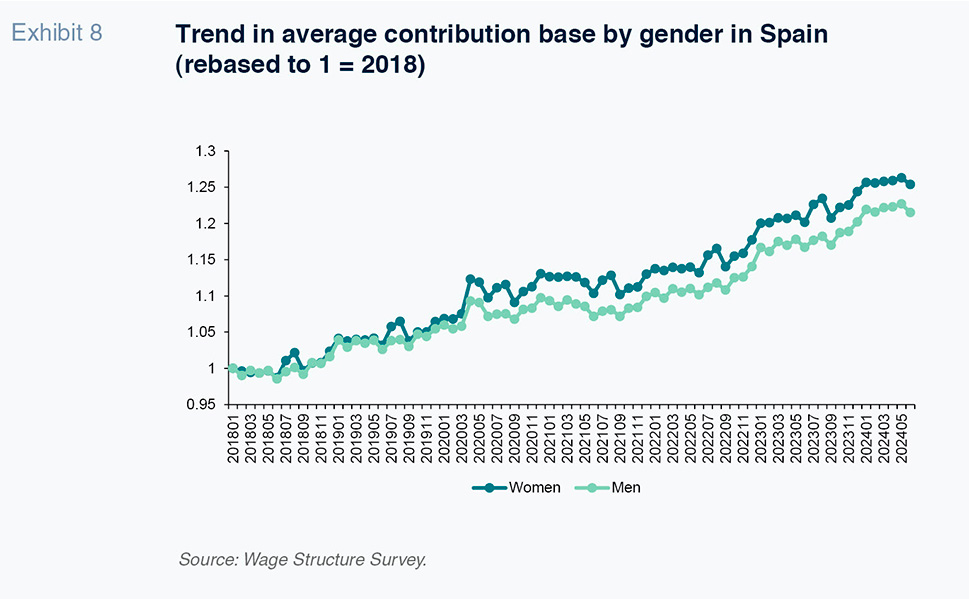
Conclusions
Whereas at the end of the last century the main labour-related challenge facing women was convergence with their male counterparts in terms of employment and participation rates, the chief challenge on the equality front this century is surely eliminating the gender pay gap. The progress made during the last 20 years is encouraging as the pay gap has narrowed considerably measured in terms of both gross annual earnings and gross hourly earnings. That success is partly attributable to higher labour intensity and significant flows of women into higher-paid sectors and occupations over the last decade.
However, the flip side is that the adjusted gender pay gap has fared significantly worse, at least in the last decade, decreasing by a negligible percentage point. Although we cannot clearly identify the reasons curbing the reduction in the adjusted pay gap, the fact that it is holding steady over time implies that in the future it will be considerably harder to continue to reduce the pay gap at the rates achieved since the turn of the century. The explanation is simple: once the pay gap cannot come down any further via increases in working hours or a greater female presence in higher-paid sectors and occupations, a structural pay gap, that will be far harder to eliminate, of close to 10% will remain.
On the positive side of things, there is recent evidence for several successful policies for reducing the adjusted pay gap, such as more equal sharing of childcare responsibilities and more flexible working hours (Goldin, 2014). In fact, the latter is the most promising line of initiative according to the most recent study published by the winner of the Nobel Prize in Economics Sciences, Claudia Goldin, who finds a non-linear relationship between hours worked and earnings, where working shorter, discontinuous hours tends to lead to a disproportionate penalty in terms of hourly wages. Although we have yet to obtain evidence in this regard, the increased incidence of working from home in the developed world may provide some of the sought-after flexibility without a pay penalty that is needed to continue to reduce the gender gap in the coming decades.
Notes
The Wage Structure Surveys undertaken in 2002 and 2006 followed methodologies that are substantially different from those carried out in the following years, most notably due to the omission of a significant percentage of public employees and, in 2022, of employees at small-sized enterprises. Although these omissions cause biases in the gaps calculated in those years, we use the original data for the first section of this paper.
References
COBREROS, L., GALINDO, J., and RAIGADA, T. (2024).
Mujeres en STEM: Desde la educación básica hasta la carrera laboral. Esade.
https://www.esade.edu/ecpol/es/publicaciones/mujeres-en-stem/DE QUINTO, A., HOSPIDO, L., and SANZ, C. (2021). The child penalty: evidence from Spain.
SERIEs 12, 585–606.
https://doi.org/10.1007/s13209-021-00241-9GOLDIN, C. (2014). A Grand Gender Convergence: Its Last Chapter.
American Economic Review, Vol. 104(4), 1091–1119.
https://www.aeaweb.org/articles?id=10.1257%2Faer.104.4.1091&os=wtmb&ref=appHIDALGO, M. A. (7 de octubre de 2024). ¿Y si no hubiera sido el SMI? La Reforma Laboral y la desigualdad salarial.
Cinco Días.
Ángel Martínez. Afi